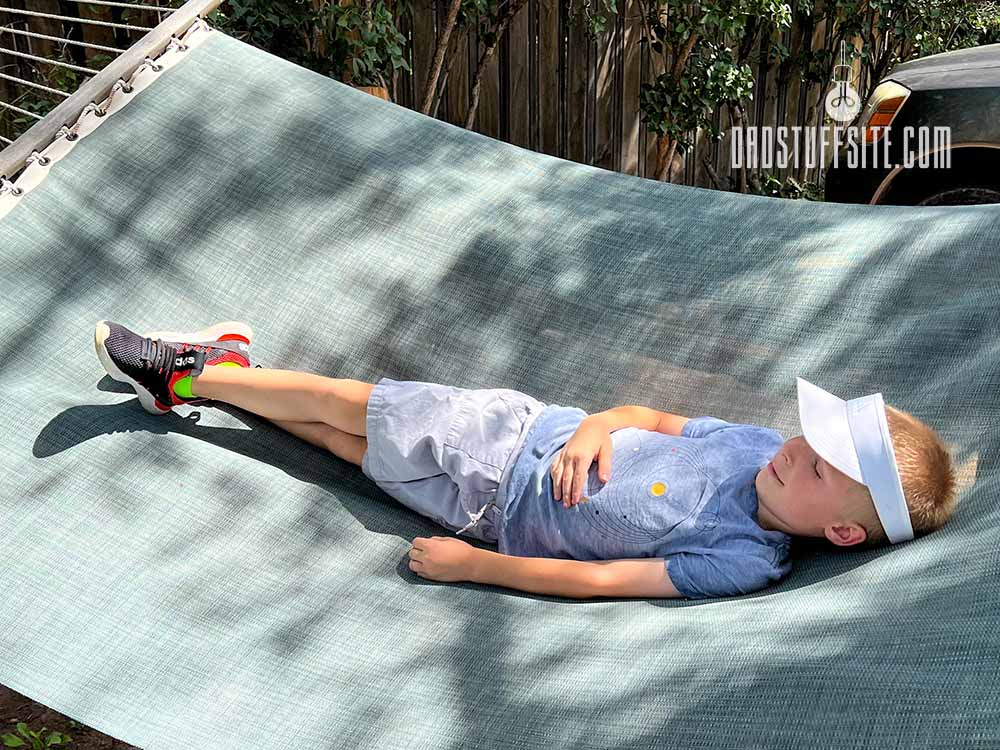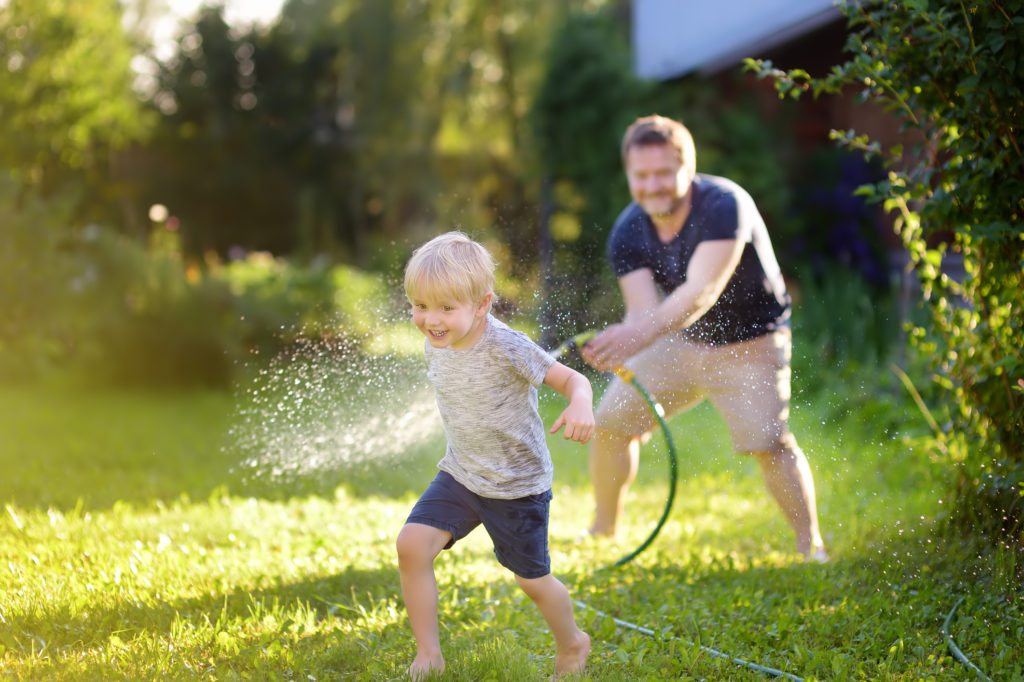
A couple of years ago, I had the opportunity to spend a month with my family in Santa Fe, NM. We were traveling for my wife’s work, and I had the summer “off” (I’m a college professor). I was full-time dad-ing while my wife worked. Although I was super excited, I knew I needed to have a game plan or I would lose my mind.
The end result is what we still affectionately call “Dad Camp.” Not only did I not lose my mind (okay, there were some low points, but no more than in normal life), but we had an incredible experience where I bonded with my two little boys. This time with my kids ended up being so impactful, it inspired me to create Dad Stuff.
So if you’re about to start summer break and you’re wondering what you’ll do with your kids, here are some tips to keep your head above water and have a great experience with your whole family.
1. Balance Routine and Variety
This is probably the biggest piece of advice I can offer. You need to create a sense of routine, with some activities that are to be done daily. During the school year, there were clear expectations for how their day was structured. It helps to create a similar sort of structure at home during the summer.
Here’s the way we (loosely) structured “Dad Camp.” I’ll give ideas for each of these activities later in the article:
- Get dressed, make beds, and brush teeth BEFORE breakfast
- Physical activity (YouTube workout, running, etc.)
- Learning time (Summer workbooks/reading, etc.)
- Family activity (hike, running errands, etc.)
- Lunch
- Quiet time/creative activity
- FINALLY some screen time

Within that larger structure, you need to have variation. While they might do certain things every morning, that doesn’t mean every day should be the same. In fact, you want to avoid getting stuck in a rut, because that’s when they get bored and problems ensue.
So you want to keep an overall structure of routine where activities within that structure can change. And also, give them a break every so often (weekends are great for this), and throw away the routine and do something completely different.
For board game ideas, check out 30 Old-School Games Your Kids Will Love (with Commercials!).
2. Learn Something
Summer Bridge Activities: I know this sounds like you’re giving your kids homework, but it doesn’t have to be. Instead of letting your kids’ brains rot and forget everything their teachers worked so hard to teach them, get a summer bridge workbook.
Summer bridge books are activity books designed to review content usually taught in the preview year while preparing kids for the following year. Activities are only 15 minutes long and can be done independently. The books are inexpensive and fun, and we get one for each kid at the beginning of every summer.
Summer Bridge Books by Grade:
- Pre-K to Kindergarten
- Kindergarten to 1st grade
- 1st grade to 2nd grade
- 2nd grade to 3rd grade
- 3rd grade to 4th grade
- 4th grade to 5th grade
- 5th grade to 6th grade
- 6th grade to 7th grade
- 7th grade to 8th grade
- 8th grade to 9th grade
Learn a Language: Another thing we do as a family in the summer is work on a foreign language. We all (including myself) spend 5-15 minutes every day doing Duolingo. You can coordinate and pick the same language to work on together, or if you can’t agree, do your own thing. While you’re at it, do some small-scale immersion and listen to some pop music of that culture or maybe find a documentary about that country.

Practice Typing: While tablets in the classroom are all the rage, learning to type is super important. If you ever want to get into more elaborate STEM and coding, you need to be able to type. So we spend a little time each day learning to type on Typingclub.com (this is a free site and is not an affiliate).
3. Physical Activity
It’s important for the kids to do some sort of physical activity every day. I find this is way more beneficial when we do this in the morning. When my boys were really young, this helped get the morning wiggles out of their system. As they get older, it helps with their energy levels so they don’t become sloths.
I’ll be honest, I’m not Mr. Fit myself, so I definitely needed to look elsewhere for help. Luckily we’re in the age of YouTube. There are great channels out there for older and younger kids. My kids’ personal favorites are Bobo PE and PE Bowman. GoNoodle also has a really good workout playlist (most kids are familiar with this channel from school).
Now that my kids are getting older, I plan to work out along with them. The workout videos of Coach Joe Wick are great to help trim the dad-bod and work out with your kids. The videos on this playlist are around 30 minutes, whereas Bobo PE and PE Bowman tend to be shorter.
Of course, you don’t need to use YouTube at all (especially if you’re looking to limit screen time). Take your kids for a walk. Find a workout and do it together. Just do something physical and remember to focus on moving, not training.
4. Have Designated Reading Time
One of my prouder parent accomplishments (along with my wife, of course) is successfully encouraging our kids to love reading. Reading doesn’t need to be a chore, but for many kids, it needs to be encouraged until it becomes a part of their daily life. In the summer, we expect them to read for at least 15-20 minutes before any screen time or playing with friends.
One of our rules of “reading time” (I’m talking about this designated time of the day, not any time they felt like reading) is that it has to be a chapter book. No graphic novels or comics (although we are all for both. More on this in a bit.). Set the timer for 15-20 minutes when you’re first starting. Eventually, as your kids get into their books, this usually goes longer.

Make frequent trips to your local library and find lots of books to check out. If this is your first time, it might be a bit overwhelming. Ask a librarian for some suggestions. The librarians running the children’s section are usually pretty amazing at giving recommendations.
Find a couple of chapter book series (my oldest son loved reading the Diary of a Wimpy Kid series and is now devouring Wings of Fire) as well as some fun graphic novels (Dogman, Zita the Spacegirl, Plants vs Zombies, and The Investigators are some current favorites) and comics (like Calvin and Hobbes and Garfield). While you’re there, check out some fun how-to-fold origami (like the Origami Yoda series) or learn-to-draw books.
5. Do a Family Activity Out of the House
I try to make sure there is some sort of an outing for all of us every day. This doesn’t necessarily mean spending a lot of money or having to plan some big adventure every day. I’m a frugal (*cheap*) guy myself, and I’m hardly the adventurous type.
Sometimes we all need to get out of the house. This can be a family hike, going to a minor league ball game, a trip to a playground, or running some errands. I like to mix in a bigger adventure (really anything that’s out of the norm) once a week. Think, waterpark, museum, mini road trip, etc.
The key is to spend time out of the house with the family. If you’re running errands, involve your kids in the process. Give them jobs like pushing the cart (some kids can be trusted more than others) or sending them out to get some items on your shopping list.
6. Plan Some Art Projects
I like to include some art activities each day. I have to confess, I’m not very artistic, especially with the visual arts. But my crappy drawing ability doesn’t mean I shouldn’t encourage my kids to have a creative outlet.
And luckily, we have YouTube to come to the rescue again (and if you’re avoiding screen time, check out some how-to-draw books at the library). There are great channels to help you learn to draw, paint, fold origami, or whatever. Try lots of different things and have fun doing it with them. The Art of Kids Hub is a great YouTube channel with lots of how-to-draw videos.
7. Everyone Helps Around the House
Nobody likes to hear the dreaded word: chores. But the truth is, your kids are a major contributor to the mess around the house, and you can’t be the only one doing all the work. This doesn’t need to be a big deal, but setting a couple of routines from the beginning is important.
One of my go-to expectations when the kids wake up is to get dressed, brush their teeth, and make their bed. There is no breakfast until all three are done (I know only one is a chore, but they don’t notice when you hide it with the other two). After breakfast, all dirty dishes need to go right into the dishwasher.
The next big one is laundry. Doing the laundry is not particularly hard, and you can teach your kids to use the washing machine as soon as they’re tall enough to reach the buttons on top of the machine.
Folding takes some more work. Either get a folding board on Amazon for around $10 or check out how to make one yourself. Show your kids how to use it and set the expectation that they learn to fold their own clothes.
If you can get dishes and laundry (somewhat) covered, your life will get significantly easier. As for the big one – straightening up the house – a once-a-week scheduled event should help.
I suggest making a detailed list (my boys still don’t understand “if it’s on the floor, it needs to be put away”) and setting a timer to do it in quick sprints. Let’s be honest, none of us want to put things away, so let’s find a way to get over it as quickly as we can.
8. Have the Kids Cook Dinner
I picked up this tip from my sister-in-law. Now that my kids are getting a little older (8 and 10 years old), I plan to start having them make a meal once a week this summer. They don’t need to make anything extravagant; simple meals are best.
Have your kids sit down and figure out a reasonable menu they can do without you (with some supervision if needed). Keep all ambitions under check here. We’re not looking to make a gourmet meal. A good kid-friendly meal might be pizza bagels (that is, pizza sauce and cheese on a bagel, not the frozen stuff), a salad from a kit, and fruit on the side.
If you’re looking for a great cookbook for kids, check out The Complete Cookbook for Young Chefs by America’s Test Kitchen. My oldest son has it and loves it. (It’s also one of the top-ranked kid’s books on Amazon.)
9. Sign up for Day Camps
Camps are great if you need to tackle a home renovation project (or just need a break from the kids). Look around in your area and see what local camps are available. So many places have great camps for different areas of interest, whether it be music, art, STEM, or a sport. Many recreational centers have programs where they do a little of everything.
Summer camps can be expensive (believe me, I know), but there are some more affordable options out there. The YMCA tends to have lower-cost camps during the summer. Your public library may have some free short programming for kids of various ages. Or you can sign your kids up for every Vacation Bible School in the city.
And if you’re the kind of parent who feels guilty about sending their kids away, remember that you’re not kicking them out of the house. You’re putting them in an environment with kids their age where they play and participate in many activities. It’s good mental, physical, and social stimulation.
10. Long-term Projects
There are a lot of activity ideas on the internet that focus on quick projects. The problem is your kids are done with the activity in an hour – which is fine if you’re looking to fill a small part of the day.
But during the summer, get your kid started on a project that can take a couple of days or even a week. Some ideas include building models, getting a basic robotics kit, or working on a stop-motion video.
If you’re new to building scale models, go to your local hobby store and ask for help. They know what they’re doing and can get you everything you need. If you don’t have a hobby shop close to home, research online and pick up supplies at Hobby Lobby or on Amazon.
Another great long-term project is some sort of robotics kit. You can get a basic 2-wheel drive beginner robot from Adafruit or an autonomous robot with an ultrasonic sensor from Sparkfun. Both companies are great for finding electronics projects (and neither is an affiliate. I personally find the education more helpful on the Adafruit site.). You can also use their sites to get inspiration and find similar kits on Amazon (usually cheaper), like this DIY robot arm.
One of my kids’ favorite projects is making stop-motion videos. You use your phone or tablet (start with the free version of the Stop Motion Studio app) and use Legos, clay, drawings, action figures, or paper cutouts to make a stop motion video. There are tons of tutorials on YouTube to get you started.
Here’s a super short video of a disappearing ninja we made last summer based on this tutorial.
11. Plan Meals and Snacks Ahead of Time
One of the more annoying parts of having the kids home all day every day is dealing with meals. The decision fatigue from feeding myself is enough. It’s much worse when you have little ones constantly asking for a snack. I know I’ve given my kids junk too often to get them to stop asking.
Take some time out to make a mini meal plan for the next day. Figure out each meal and all the snack times. Once you have the decision made, it’s much easier for you to stick to it. It also makes it easier to set expectations for the kids.
12. Schedule Family Movie Nights
While it’s easy to just let the kids watch what they want to watch, save some of that screen time for family movie/show time. The kids need to learn that watching something is just as much for you as for them, and that sometimes you want to pick a show, too. So make some Kool-Aid Candy Popcorn and a homemade slurpee and watch something as a family.

This is the perfect time to introduce your kids to some of the great movies of your childhood. Some of my personal favorites are E.T. the Extra-Terrestrial, Hook, Back to the Future (you usually need to slog through the second one just to get to the third), Jurassic Park, and Indiana Jones (just skip Temple of Doom and Kingdom of the Crystal Skull. They’re bad.).
You can also go classic and introduce them to great movies like Singing in the Rain, An American in Paris, or (my personal favorite and a lesser-known bit of brilliance) Court Jester. You can also do a family binge of the MCU or Star Wars movies. Or (another family favorite here), an Iron Chef marathon for some cooking inspiration. My boys LOVE it.
13. Schedule (Limited) Tech Time
It’s become a little too easy to give kids a tablet or phone to play on when they’re bored. There are so many health, sleep, development, and mental health reasons to limit the amount of screen time we allow our kids (if you want to learn more, check out this article here).
That being said, sometimes they (just like us) need a little break. Limited tech time is not a bad thing. But we also have to teach them boundaries and limits. The first thing to do is to set a timer. Thirty minutes for each kid is usually enough Minecraft to get it out of their system.

The other big rule in our house is that we need to finish the things that need to be done before starting tech time. For us, that means any daily chores and practicing their instruments. Over the summer it also means they need to finish summer bridge, reading time, and do some sort of physical activity.
By the way, if you need help inspiring your kids to practice their instruments, check out my article: Getting Your Child to Practice Music: 20 Tips for Motivation.
It also means we usually don’t have tech time in the morning. If the point is to have a break, then we need to do something first. You don’t usually need that break first thing in the morning, even if you finished all your responsibilities.
14. Have Quiet Time Every Day
After a day of being together, we usually need a break from each other (this is as much for the parents as it is for the kids). While my kids can play great together, they can also get on each other’s nerves and bicker. A little space each day helps to manage these issues.
I typically schedule quiet time right after lunch. After a morning of activities and a nice lunch, we’re all ready for a break anyway. I’ll set the timer for an hour (when they were younger and took naps this was longer) in which they hang out in their rooms. They can do just about whatever they want – reading, napping, listening to a podcast, playing. But they have to do it on their own.

15. Plan Occasional Theme Days
Themed days can follow a holiday, special event, or just be random. If it’s an Olympics year, we like to have a big international day leading up to the opening ceremonies. We’ll plan meals that are from different countries (or the host country) and go for a jog in the morning (as if we were passing the baton).
You can eat like a hobbit and have seven meals throughout the day. Fill the day with a marathon of all things Lord of the Rings (which now includes the new Rings of Power series on Amazon Prime). Build your own Helms Deep fort with couch cushions or shoot suction cup arrows like Legolas.
Or tie it into their language of choice (see #2) and plan activities and meals around a specific country. Or around whatever movie you’re watching for Family Movie Night (#12).
16. Go Outside
Part of the regular routine needs to include some sort of outdoor time (weather permitting of course). What they do outside doesn’t necessarily matter, as long as they get some vitamin D.
I don’t want to sound like a crotchety old man complaining about “when I was a kid…”. But the truth is, nowadays a lot of kids are so used to having a screen in front of them (and let’s be honest, we’re guilty of this too) that they often don’t know how to handle being bored.
This is when I shove my kids outside and say they can’t come back in for 30 minutes. After the initial complaining, they end up inventing some sort of game. This usually leads to a much longer outdoor playtime.

If they want to come in after the 30 minutes, it’s because they’ve played hard and it’s hot. I recommend turning on the sprinkler and letting them splash around with the hose. They’ll be so thoroughly worn out, they’ll be much easier to handle the rest of the day.
17. Do a Treasure Hunt
If you’re new to Dad Stuff, you’ll quickly learn I love making treasure hunts for my kids. Not only does it mean I teach them some sort of secret code or cipher, but it also means I get to tease their imagination. I love that I get to leave some sort of clue for them to “discover” that leads them on their own National Treasure-style adventure.
If you need some inspiration to get started, check out my treasure hunts using the Caesar cipher, the Ottendorf cipher, and the book cipher. Each hunt will include all the clues you need and how to do each cipher.
Related: 6 Secret Codes and Ciphers to Teach Young Kids
18. Have a List of Random Activities for When You Get Stuck
Even with the best preparation, sometimes you get to a lull in the day where everyone’s a little bored. Have a list of random activities that take about an hour. Put them on individual pieces of paper, put them in a bowl, and have a kid pick one out. We call this the Boredom Jar (or if you want to be extra, put the paper in small balloons and tape them to a board. Throw a dart to pop the balloon with today’s activity.).
To learn more, check out The Boredom Jar: 30 Activities for When Your Kids are Bored

Some random activities can include going to your local brewery to play a board game (and bonus – get a beer for you), building a couch fort, painting a picture (following a YouTube tutorial), sending postcards to the grandparents, going for a long walk, making a movie, or watching a cooking show and making the recipe yourself (Alton Brown’s Good Eats reruns are great for kids).
Related: Become Penpals with an Alien (Pigpen Cipher Activity)
Whatever you pick to put on your list, make sure it’s something you can do any day. The kids get frustrated when you choose going to the planetarium only to find out its only open on the weekends. Not that I made that mistake before….
Related Posts
When I was younger, so was my son. And at that time in our lives, I found myself cajoling him to poop regularly. It was in his best interest to learn to drop the deuce, I...
Recently my oldest son and his friends have gotten super into dragons. They’ve been reading the Wings of Fire series by Tui T. Sutherland (a great read for your kids by the way), and now...

